|
Bromeliads: One Is Never Enough
By Andrea Busk
Okay, I'll admit it - I have developed quite an obsession for Bromeliads. The strappy rosette(s) of intricately colored and patterned foliage is outrageous enough. When you add in the exotic tropical flowers some of them get that can last for up to 6 months it is too much fun for this gardener to resist. An obsession that was further encouraged by my recent trip this winter to the Tropical Plant Industry Expo, while there I stumbled upon a really amazing grower who is going to help all of you become just as obsessed as I am. Sorry!
Bromeliads are members of a plant family called
Bromeliaceae. This family encompasses over 3,000 species and thousands more hybrids. Most are native to the tropical Americas and they can be both epiphytic or terrestrial in habit. An epiphytic bromeliad will ordinarily be found growing on a tree or a rock and will primarily use it's hard, wiry root system to hold on and not for nutrients. A terrestrial bromeliad grows in soil and has a complex root system where it gathers sustenance. Diversity in the bromeliad family is also displayed by the way in which various species have adapted to take in water and nutrient. There are the tank bromeliads that store water in a cup created by the vase-like structure of its leaves, the Tillandsia species that take in water only through specialized structures on their leaves, a large group that store water in their dense, overlapping leaf structures and still others that are succulents and store water in their leaves.
A bromeliad's flashy rosette comes in a wide variety of colors and patterns & make's a stunning addition to a mixed annual container. Placed beneath a large elephant ear or canna, a bromeliad can act as a large 'flower' and add a bold, tropical punch. The genera, Neoregelia are particularly wonderful at this. The leaves are usually broad, the overall height is smaller (usually 6-12") and the color variations of the leaves is seemly endless.
Neoregelia 'Guacamole'
Neoregelia 'Guacamole' is bright green with rich burgundy mottling along it's leaves, that clusters well and can be planted en masse below Colocasia 'Black Coral' for a dramatic effect and a low maintenance container. Neoregelia 'Sibella' has leaves that are lime green with a bright pinky-purple center. It's upward, and arching rosette of leaves make it a perfect candidate to act as a large flower along the side of a planter.
Neoregelia 'Sibella'
Tillandsias and Dyckias are more narrow and often times have sharp teeth along the outer edges of their leaves. They come in grays and silvers and burgundy colors and they make a great addition to a succulent container because they are also extremely drought tolerant. Xerographicas, for example, are a vibrant silver-white that takes in moisture thru the structures on its leaves. Dyckia 'Grape Jelly' is, well the color of grape jelly and will add a nice pop of color to succulent containers that tend to have a lot of greens and silvers. Although Dyckias are drought tolerant (and terrestrial) these plants love regular watering and will grow more robustly if treated this way
Some of the most impressive and exotic inflorescences (flowers) are found among the Aechmea and Vriesea genera of bromeliads. Flower bracts rise out of the center cup and can reach up to 4' on some and can last for months. Aechmea 'Blue Tango' produces an electric inflorescence of hot pink and bright blue that stands high above the foliage. Once in flower it will stay that way for at least the entirety of our growing season and then some.
Aechmea 'Blue Tango'
Aechmea 'Zebrina Pink' has both striking frosty-white banded foliage and a lemon yellow bloom with large baby pink petals. And Billbergia "Hallelujah' has deep burgundy leaves with creamy white speckles that glow like a starry night when sun lit from behind. It's flower is a creamy white, red and blue that lasts only a week or so. In each case, these plants make a stunning statement either on their own in a container or as a low maintenance addition to a tropical landscape or combination planting.
To make it easier to grow and handle you can plant most bromeliads in soil, except for tillandsia which ought to be mounted on wood or some other surface. They should be potted in a shallow container that should be kept on the smaller side so as to prevent over-watering. Bromeliads will grow in almost any potting mix as long as it has quick drainage and provides stability. Most of the bromeliads we have planted here at the Nursery have been planted in our alpine soil mix which has allowed the plants to thrive because it offers for rapid drainage.
Bromeliads do not like to be planted deep or have soggy soil, each of those conditions will cause your plant to rot. Keep the central cup, if there is one, filled with fresh water and do not allow the water to get too old or stagnant or this will also cause the plant to rot. Given the intensity of the sun in our Northern clime, almost all bromeliads with thrive in a part sun location. Some will even take our full sun with no problem and we have grown many successfully here at the Nursery in full sun locations. As for feeding bromeliads, there is a variety of opinions on this topic. Essentially it depends on the genus and the growing/light conditions. Many growers believe neoregelias and stiff-leaved aechmeas do better if they are grown in conditions that are slightly more stressful. Vrieseas, however, require some fertilization to foster large, vibrant flowering. Either way, a small amount of Osmocote in the soil and a significantly diluted biweekly fertilization during the growing season is all that the plants need.
You can enjoy your bromeliad for many years because they make easy plants to overwinter. As long as you keep an eye on your watering, making sure you do not rot your plant under these new indoor conditions, you should be fine. Just keep in mind, that after a plant has bloomed it will die over the next year or two - this is not your fault! During that time it will produce new pups that can be easily removed from the dying plant and then potted.
Come and see the bromeliads we will have to offer this year - you will not be disappointed, in fact you'll probably become a bit obsessed.
|
|
Plant Profile: Asimina triloba
By Vincent LoVerme
Asimina triloba, commonly known as Pawpaw or Custard Apple, is an intriguing small tree that in my opinion is both underutilized and underappreciated. Even though it's a member of the tropical family, Annonaceae, it's actually a temperate eastern North American native. I find that to be pretty cool. If you think about how much of the fruit we eat every day is actually native to the eastern U.S., you'll realize there is very little. It can be found growing wild in 25 states and is hardy from zones 5 to 8.
Pawpaw is a deciduous large shrub or small tree that can grow to 15-20' tall and wide, usually with a multi-stemmed suckering habit, but sometimes with a single leader and pyramidal form. They are often seen growing as an under-story tree in deep soils along streams and river bottoms, as they prefer moist, fertile, acidic soil with lots of organic matter. They are tolerant of full sun and also heavy shade. The foliage is large and dark green in summer with a semi-tropical appearance, and in autumn turns to a nice and sometimes brilliant yellow. The small maroon bell shaped flowers appear in early to mid spring and last for up to six weeks.
Though the flowers aren't particularly showy, they are quite unique, and with adequate pollination, produce a superbly interesting and tropical-like fruit that resembles the mango. This edible fruit is technically a berry, though is doesn't appear as such, and is generally oblong in shape averaging 2-5" long.
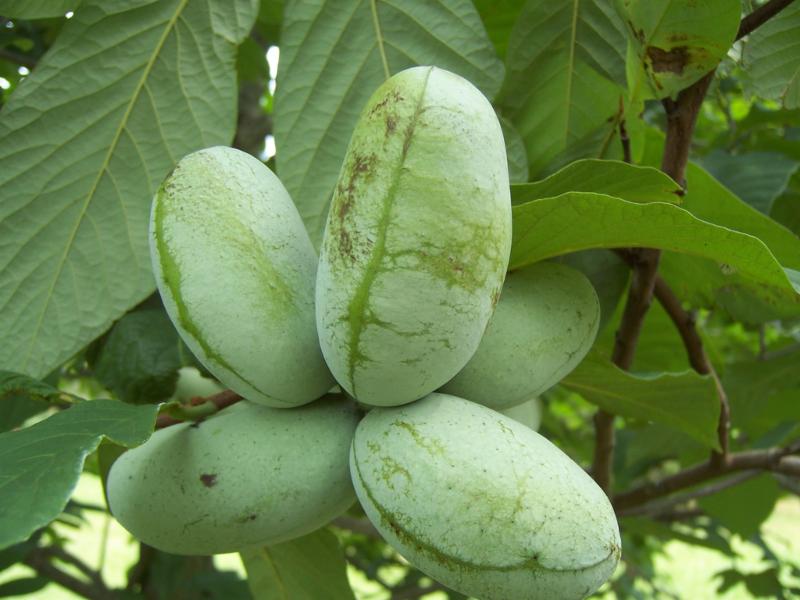
Some cultivars produce even larger fruit that can weigh as much as a pound or more. They ripen in late summer through fall and mature from green to yellow-green, to brownish black. The highly aromatic fruit has a creamy custard-like texture and has a tasty, tropical, sweet flavor, which is a mix of banana, mango, and pear. They can be eaten fresh, or used to make all sorts of desserts from custard to jam, pie and even ice cream. They have excellent nutritional value, actually more so than apples, peaches and grapes. They are also high in unsaturated fats, proteins, and carbohydrates, and have a good balance of amino acids. The leaves and bark of Pawpaw have anti-fungal properties and contain compounds that are used medicinally to make pesticides and anti-tumor drugs. So as you may have guessed, Pawpaws are highly resistant to insects and disease, and are also completely deer resistant.
So with all these outstanding characteristics, why has the Pawpaw never become popular? And why have you never seen the fruit at the grocery store? For two good reasons. First off, pollination is often poor and difficult. Pawpaws are pollinated by flies and beetles which tend to be unreliable and of limited availability.
The genus Asimina is the exclusive food plant for native zebra swallowtail butterfly larvae.
Pawpaw farmers often resort to using hand pollination and/or pollinator attractants to improve fruit set. Aside from attracting pollinators, it is also necessary to have more than one variety or seedling to improve cross pollination and fruit set. Secondly, the shelf-life of the fruit is very poor. They can only be kept for 2-3 days at room temperature, and can be kept for up to 3 weeks if refrigerated. You may see them offered at farmers markets for this reason but rarely or never at the grocery store. Some hybridizing has been done to improve production and shelf-life, but it seems more is still necessary to overcome these challenges. Also recently, some new cultivars have been introduced with improved flavor and aesthetics, mainly in an attempt to make them more attractive and appealing to the public.
A lot of American history revolved around the Pawpaw. It has long been cultivated by Native Americans and early colonists. Survival of the members of the Lewis and Clark expedition depended greatly on wild Pawpaws. George Washington's favorite dessert was chilled Pawpaw fruit, and Thomas Jefferson had it planted at Monticello. Even Daniel Boone and Mark Twain enjoyed eating them. With Pawpaws being so deeply rooted (no pun intended) in the history of the U.S., you'd be amazed to know how few modern day Americans have ever heard of Pawpaw, much less tasted the fruit. So why not consider planting this piece of American history. They are perfectly suited to the shrub border, would make a great under-story tree on the woodland edge, or perhaps a nice addition to an orchard. You'll be amazed how little attention they require and how bountiful and flavorful the harvest just may be!
|
|
Miniature Iris
Anyone who has even casually leafed through a hybrid Iris catalog has to admit their flowers can be over-the-top. Whether that means flashy colors, intricate markings or frills and ruffles there is something available for the most extravagant of tastes. Even the miniatures can sometimes flaunt these features to some extent. And why not? They come from similar areas and have in some cases been subject to the hybridizers attentions.
In general Iris are easy. Don't misunderstand, there are certainly some difficult Divas. The extraordinary Oncocyclus and Aril Iris come to mind, with their intricate markings, dramatic spots and crazy Gibson-Girl silhouettes. They are challenging and require pot culture or a dedicated bulb frame or house to keep off the rain, particularly for the all-important three months post-bloom. During some lecture or other I remember hearing that their sickle-shaped leaves are designed and positioned in such a way that precipitation is
funneled down the length of the leaf and delivered to the crown.
This would make a rainy wet habitat anathema to the genus. So if you don't already live in Asia Minor I'd hesitate to inflict these troubles upon you.
Luckily, this year we have a beautiful contingent of dwarf and growable Iris to tempt you instead, some even small enough for troughs. We have photographs of most of the flowers to show you, in a folder in the Kiosk, just ask.
One I personally can't wait to see in flower is Iris 'Ice & Indigo.' At 10" tall, it is probably best in the rock garden, the flowers have crisp white standards and falls bearing a deep blue/violet spot, prettily filigreed around the edges. Introduced in 1991, it is an early bloomer.
Another whose blooms we breathlessly await is Iris 'Jive.' I have had this one on my radar for a while but up till now had no source for it. Another Standard Dwarf Bearded (SDB) this is a bicolor in delicious golden apricot with a big raspberry splotch on the falls and bright red beards.
Iris 'Footlights' is one we have been building up our stock on for years. It is truly tiny, maxing out at about 4." It's a bright yellow self (self means one color for both standards and falls.) A very early bloomer it will be perfectly in scale in most troughs. It is quite rare in the trade, we got our start from other Iris aficionados. We will have a limited number to offer. Iris 'Little Joe' came to us from the same source and reaches about 5". It is dark violet, also early blooming and in limited numbers.
Three beauties are returning to our benches after a number of seasons being unavailable. The always popular and striking
I.
'Fission Chips' will be back. A lovely soft orange self with red beards. Another returnee and a favorite is
Iris aphylla
, long time denizen of the Oliver wall garden. Blossoms of a rich violet blue with contrasting beard hover above the short swords of the leaves. A floriferous species. This one also takes time to build up stock for sale, look for it this year.
Although we will have quite a few others available (check the catalog for a complete list) the last returning treasure is
Iris
Wine Spritzer. The flowers are rose-purple with a deeper red spot on the falls and a pale beard with touches of gold.
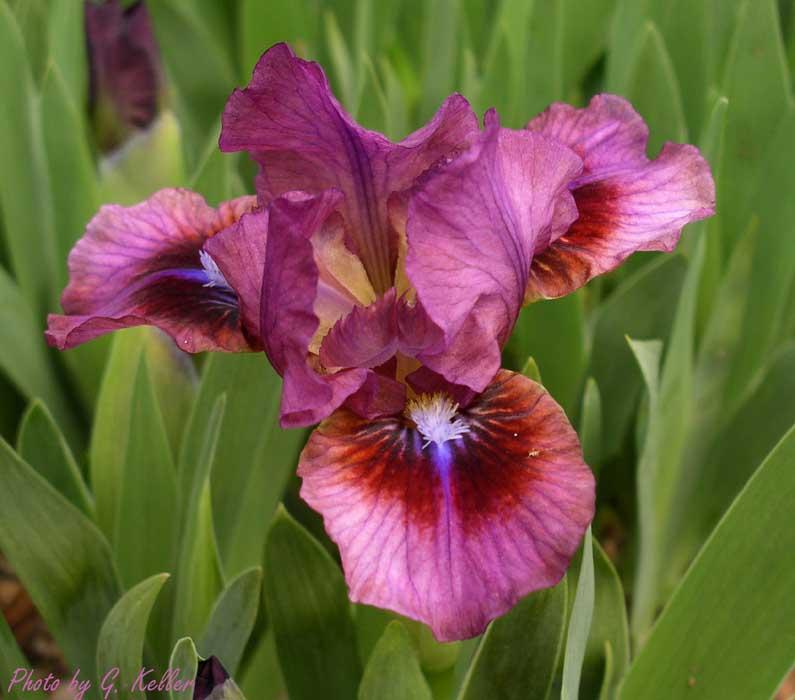
These miniatures seem to spend years blooming happily away in troughs, the floral display increasing over time. Eventually though, the rhizomes will simply run out of real estate. At that juncture it may be time to divide them. If they need it they will often telegraph the message by decreasing blossoms, smaller leaves and sometimes a bald patch in the center. Dividing is best done within a few weeks after flowering. Unlike their taller cousins, where division is a major digging operation , these small iris can be lifted with a trowel or dandelion weeder, snapped or cut apart, then reset with a little fresh soil below them. Extras can go to decorate other troughs, the garden proper, or used to garnish stones or steps. They are also a perfect gift for like-minded plant lovers.
So whether your aim is to add to a growing iris collection or you are ready for the first time to dip your toe into the dwarf iris gene pool- this is a great year to do that. Come browse our small-in-stature but diverse and curated selection. If a fleur-de-lis deigns to open while you're searching the benches, I'm betting it winds up in your cart.
|

Natural Methods of Pest Control
By Christopher Ashcroft
We rejoice with the first signs of spring and we're not alone. I'm not referring to alien life or that the truth is out there as Fox Mulder believes. I'm referring to the pests that many gardeners in this region are familiar with and some, unfortunately, may know all too well. In this article I'll be pointing out organic methods for ridding your garden of some of the common pests in the area. Attracting natural predators such as birds, praying mantis and lacewings are a great start, but there are many more options out there to keep in mind.
Aphids - These insects tend to focus on new growth and stems where they suck out the nutrient-rich sap, thus depriving the plant of what it needs to thrive. As Aphids feed they secrete honeydew which is an encouraging setting for sooty molds which can deprive plants of sunlight as they spread. These pests reproduce quickly so waste no time!
To ensure this does not happen there are a few reliable options.
Neem Oil has natural chemicals that act as a repellent for Aphids as well as many other common garden pests. Dillute the oil with water accordingly and spray on the plant thoroughly. You may also do this with a few tablespoons of dish soap should you not have any Neem Oil handy. Other helpers already in your garden include Ladybugs, Lacewings and birds that will feast on Aphids.
Deer
- Few people in this region can say they don't have a deer issue. They will devour all they can and will continue to return to areas with a food source.
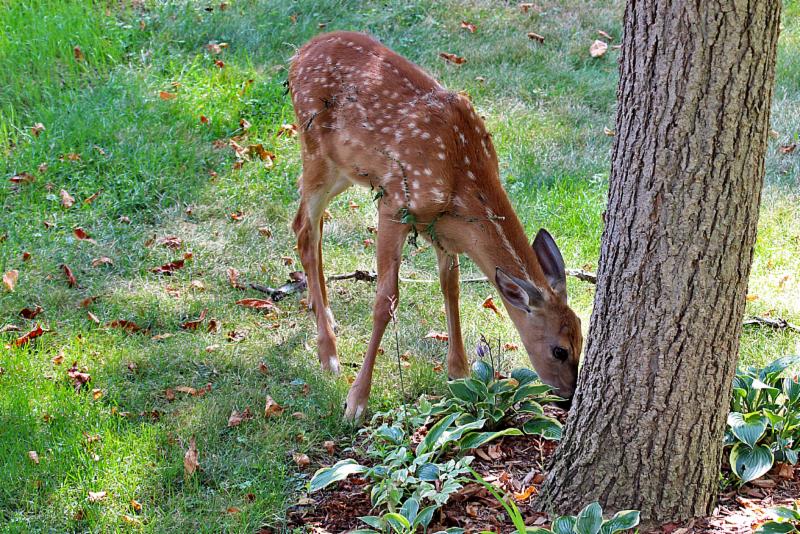
These days the best defense seems to be an organic spray called DEER OUT that can applied to plants on a monthly basis or more depending on the amount of rainfall. You can find DEER OUT at the nursery and many have made it their standard defense. Besides spraying you can look into fencing and planning your garden out with plants the deer don't prefer is always a solid route to take.
Japanese Beetle - The cleaner you keep your garden the less you should see of these pests as they're attracted to diseased plants. Dispose of any dead or decaying plants and debris during your spring cleanup to discourage any visits like the one below.
Spreading beneficial nematodes or Diatomaceous Earth is quite an effective method to rid yourself of these pests. Nematodes are tiny worms that will kill the grubs and many other common pests in the soil. Diatomaceous Earth is discussed below in the slug section and will certainly take care of your Japanese Beetle dilemma should you spread it early enough.
Slugs
- When it comes to slugs you have a number of ways to rid them from your life naturally. Let's have a look.
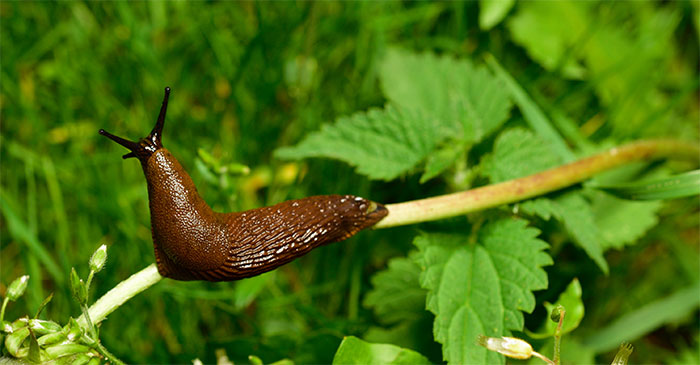
- Beer traps - Slugs are attracted to the yeast in beer and will come from all over the garden to have a drink. Take a tin or a plastic bottle that has been cut in half and insert it into the soil so it is flush with your garden bed. Fill the container half way with beer and wait. The slugs will crawl down the container to sip and fall in and drowned.
- Citrus rinds - Hollow out the rinds of grapefruit or oranges and place them out in the infested area(s) at night. In the morning check and you should have quite a few in the rinds ready to throw away.
- Copper rings - Copper creates a small electric current when it meets the mucus of a slug. You can use rings, strips or mesh to guard your plants, but they will require the occasional cleaning as copper does tarnish.
- Diatomaceous Earth - Think of powdered glass and you'll get an understanding of how this works. Don't inhale this stuff! DE is from fossilized diatoms and is a pale, powdery substance. Insects with soft bodies will be cut by the DE, dehydrate and die. Spread the powder in the affected area, but understand this can also harm beneficial insects. I'd recommend using this sparingly.
- Egg Shells - Egg shells work in the same manner that Diatomaceous Earth does. Break up the egg shells until fine and spread them around your plants. The slugs will not crawl over such a sharp material.
- Sandpaper - Imagine dragging your skin over some sandpaper. For obvious reasons, slugs are not going to make their way across any sandpaper.
- Seaweed - Not only is this good for your soil, but it will keep slugs at bay. The salt in seaweed will keep them away. Make sure you lay more than one strip around as it will dry up.
Soft Scale
- These pests enjoy garden and ornamental plants and will suck the sap from them, like aphids, resulting in suffocation and a dead plant if not dealt with. The best option for ridding your plant(s) of scale, like aphids, is Neem oil. Dillute the oil with water and spray sufficiently.
|

Made In The Shade: Tropical Ferns
By Andrea Busk
When you're talking about a plant species that predates the dinosaurs, you know that these plants are certainly adaptable and durable. Most of the approximately 12,000 species are native to tropical forests. Tropical ferns are easy to grow and require little more than dappled or bright shade and rich, moist soil with good drainage. The ones we carry are real stars for the shade landscape or container - offering delicate texture and fronds in rich greens, silver-blues and chartreuse. The great variety in texture and color allows you to experiment with combinations of just ferns or just set them off against a plant with texture. They're beautiful used simply alone as a centerpiece. All will yield satisfying results. Here are just a few we will carry:
Adiantum peruvianum - Silver Dollar Maidenhair Fern
Silver dollar-sized leaflets are attached to wirey ebony colored stems in graceful, arching sprays of foliage. New leaves have a pinkish-tan cast with a slight metallic sheen. A native of South America it prefers bright, diffused light.
Nephrolepsis exaltata 'Rita's
Gold'
A brilliant chartreuse Boston fern that provides a bold color and texture contrast for a shady area. Grows a bit smaller than other Boston ferns. Best color in bright light or morning sun. A very easy fern to grow as long as it is not over-watered.
Polypodium
aureum 'Blue Star' - Blue Star Bear Paw's Fern
An easy to grow fern with powder blue leaflets on upright one to two foot strappy leaves emerging from furry rhizomes. In its native South American rain forest habitat, this fern grows like an epiphyte and uses its roots to hold onto the branches of trees and not for nutrients. It adapts to growing in soil but it must have good drainage. Likes to be kept moist but hates to sit in wet soggy soil. Glaucous blue color is best when grown in some sun.
Asplenium
nidus - Bird's Nest Fern
This one is for bold texture! Each leaf has a gorgeous glossy sheen that can reach 3-5 feet long and forms a vase-shaped cluster. We will carry some larger ones of these, that will be great on their own or as a centerpiece for a mixed container. Indirect light and moist to drier soil. Likes good drainage.
Maidenhair Fern
(Adiantum raddianum, tenerum, capillus-vernus)
With their delicate, graceful foliage, maidenhair ferns are a large group of ferns with over 150 species. We offer several varieties - some bright green, some with a hint of variegation and some with a burnished pink-red cast to its new growth. All of them are favorites here with their lacy, arching foliage. A lovely contrast to bolder foliage. Prefer bright, indirect light and moist, not soggy soil.
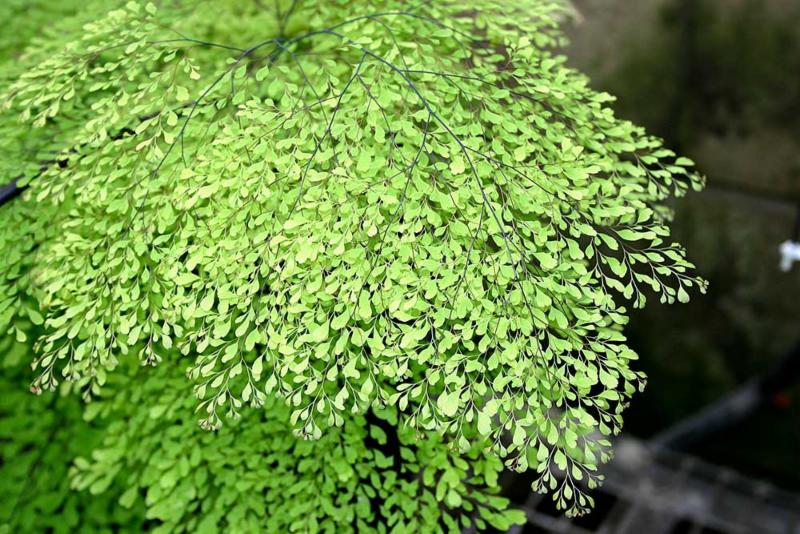
|

Weekend Outings For The Green Thumb
By Lori Chips
© 2017
It is rare for an avid gardener to have any spare time in the spring. Our gardens exert what seems to be a magnetic pull on our hearts and on our attention. But that doesn't mean that we shouldn't avail ourselves of the spring riches that pop up on our calendars in such tempting abundance at this time of year. Here are a few to cajole you away from garden chores that are completely worth playing hooky for, some of them held at astonishingly beautiful sites and some carrying noteworthy historical significance as well.
On April 29
th
the 11
th
Annual Stonecrop Gardens Alpine sale takes center stage for all those rare plant fiends out there. This one is always breathlessly awaited by a plethora of rock garden aficionados. It starts at 9:00am and is over at 3:00pm. There is a modest entry fee of $5.00.
The Vendors that attend and sell at this event are extraordinary, and incredibly dedicated to their art & craft. They are as follows:
Stonecrop Gardens
Wrightman Alpines (Be sure to take a look at Esther Wrightman's beautiful photos of their equally beautiful plants online at
www.wrightmanalpines.com)
Broken Arrow Nursery
Garden Vision Epimediums
Edgewood Gardens
Bill Perron Cyclamen
Don Dembowski
Opus Nursery
Pope's Pots
Jay's Conifer Nursery
Stonecrop Gardens was once the home of Anne and Frank Cabot, legendary plantspeople and garden makers. (They also created the spectacular Les Jardins de Quatre Vents in Canada.) Stonecrop was opened to the public in 1992. It is a glorious setting with extensive gardens. There is a definite emphasis not only on beauty, but on practicing good horticulture. The many features include raised stone beds cradling alpines, planted troughs, a cliff rock garden, woodland and water gardens, an English flower garden, systematic beds for over 50 plant families and a conservatory. You may want to spend a few hours here, and since there is nowhere to buy lunch it behooves everyone to bring their own.
Don't miss the splendid quarry with a huge stone used as a bridge, the Moon Window, the pithouse and the grove of maturing Metasequoias! Be prepared to be inspired.
The last chronological spring event (at least for now!) Is the Tower Hill Botanic Garden Primrose Show. This is presented by the New England Chapter of the American Primrose Society, often in conjunction with NARGS. Tower Hill is located about 8 miles north of Worcester Ma. At 11 French Drive, Boylston Ma. It runs Saturday May 6th
from 10:00 am to 5:00 pm and Sunday May 7
th
from 10:00 am to 4:00 pm. The show is free once you pay admission.
Concurrently the Daffodil Show will be running offering an added attraction, with slightly different hours on Saturday: 1:00pm to 5:00pm. The grounds are eminently worth seeing, and the primula show draws expert growers and viewers alike. For more information go to
www.towerhillbg.org.
|

- Edgeworhia chrysantha - It's a shame this picture is not scratch and sniff. What is there not to like about this shade tolerant shrub that the deer don't prefer?!
- Aubrieta 'Royal Blue' - A lovely variety of Rock Cress brightening up our rock garden.
- Corylopsis pauciflora - Nothing quite like Winter Hazel this time of year! Buttercup yellow blooms that are mildly fragrant.
- Primula vulgaris - Check out the wine red blooms on this little one! We've got a handful of great varieties to chose from.
|

4/28:
Tree Warden Association of Connecticut 25th Anniversary Workshop and Celebration @ Omni Hotel (New Haven) - Click here for more info
4/28: CT Horticultural Society's Spring Plant Sale & Auction @ Bethany Covenant Church (Berlin) - Click here for more info
5/12: Westport Garden Club Plant Sale @ Great Lawn at Saugatuck Congregational Church (Westport) - Click here for more info
|
|